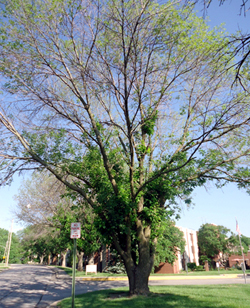Emerald Ash Borer (EAB) Confirmed in Johnson County

Early stages of Emerald Ash Borer infestation in an ash tree.
EAB in metro KC
- The Emerald Ash Borer population is now established throughout Johnson County and the metropolitan area.
- Johnson County K-State Research and Extension is recommending spring treatments for valuable trees to protect them from EAB. Should you treat?
- Johnson, Wyandotte, Leavenworth, Douglas, Atchison and Jefferson Counties in Kansas are under quarantine, as are all of the counties in Missouri.
How the insect spreads
Emerald Ash Borer adults can fly at least 1/2 mile from the tree where they emerge. Many infestations, however, were started when people moved infested ash nursery trees, logs, or firewood into uninfested areas. Shipments of ash nursery trees and ash logs with bark are now regulated, and transporting firewood outside of the quarantined areas is illegal, but transport of infested firewood remains a problem. PLEASE - do not move any ash firewood or logs outside of the quarantined area.'
Points to consider when dealing with EAB
1) Make sure the tree in question is an ash tree.
- How To Identify an Ash Tree
- If you are certain the tree is an ash (white or green), continue below.
- Uncertain of the tree species? Contact Extension at garden.help@jocogov.org for identification assistance, either by e-mailing photos of the tree or by bringing a sample to the office.
2) Symptoms of EAB
- Twig dieback in the canopy or other branches of the tree.
- Sucker growth from the main trunk or around the base of the tree.
- Borer exit holes. EAB borer holes are very difficult to see. These holes are usually not seen unless you are a trained spotter or the bark is peeled away. If you can easily see the holes it is unlikely to be EAB. There are many types of borers, including the very common native borers which have always been present.
- Borer hole size for native borers: about the diameter of a #2 school pencil and round in shape.
- Borer hole size for EAB: about the diameter of the lead in the pencil and “D”-shaped, not round.
- Presence of adult insects. Adult EAB beetles are small, 1/8 to 1/4 inch and narrow, about the diameter of a flat toothpick, and metallic green. They are very difficult to see.
- Visual guide: Kansas Emerald Ash Borer CSI
3) Should you treat for EAB?
- Only highly valued trees in excellent condition should be considered for treatment.
- Trees with defects, such as decay, poor branching or in decline, should not be treated.
- Treatment should be considered a lifetime commitment. Depending on the method of treatment, you must treat every year or two, for the total life of the tree. One-time treatments do not work against EAB!
- Properly applied treatments are highly effective in controlling EAB.
4) What are the methods of treatments?
- Trunk spraying: Done every year and applied in the spring, prior to the emergence of the adults, from mid-May through early August. Recommended for commercial applicators only.
- Soil drench: A yearly application done by either homeowners or commercial applicators. The product is applied either in spring or fall depending on the product.
- Trunk injections: Applied every two years by a commercial applicator, normally done in early spring to early summer. This is the preferred method of treatment supported by the most research.
- For complete information about control options visit: Insecticide Options for Protecting Ash Trees from Emerald Ash Borer
5) Can a homeowner apply the treatments themselves?
- There are products on the market for homeowners that are a soil drench. These insecticides must be applied according to the product label. This is the law and violation of the label will harm non-target pest and could result in a prosecution. Read the label as misapplication leaves you liable.
- Must be applied yearly.
- Only recommended for trees under 20 inches in trunk diameter (measured at a height of 4 feet from the ground), some research suggests up to 15 inches in diameter. Read the label as most homeowner products limit the maximum rate that can be applied. Homeowner application will often exceed the limits roughly when the tree reaches 10 ” in trunk diameter or you have multiple trees on your property. READ THE LABEL — it is your responsibility to apply it properly
- For complete information about control options visit: Insecticide Options for Protecting Ash Trees from Emerald Ash Borer
- Make all applications at the rates and times indicated on the label. Some product labels will vary on timing of applications.
6) Should we start treating our trees?
- If you wish to save your tree/s, trees in good or excellent condition should be treated to protect them from EAB. Trees in poor condition (weak, damaged, poor structure) should NOT be treated.
- Do your research,
- Get quotes, and
- Make sound decisions based on science, not on impulse.
- Treatment will be a personal decision based on your judgment of
- the tree’s value,
- treatment cost and
- tree replacement cost.
- Remember only trees in good or excellent condition should be considered for treatment.
- Decision Guide for Treating Ash Trees
by Dennis Patton, horticulture agent
Official Source for Information on Emerald Ash Borer in Kansas
Video
More Information On Emerald Ash Borer (EAB)
- How To Identify an Ash Tree
- Commonly Asked Questions about EAB
- Decision Guide for Treating Ash Trees
- Insecticide Options for Protecting Ash Trees from Emerald Ash Borer
- Kansas Emerald Ash Borer CSI
- EAB Info Network
Resources for Selecting a Reputable Tree Service
- How to Contact an Arborist
- Selecting a Certified Arborist in Kansas
- Verify an ISA Certification / Find a Tree Care Service
Replacing Your Ash Tree
- Recommended Landscape Trees for KC - K-State Extension/Johnson County